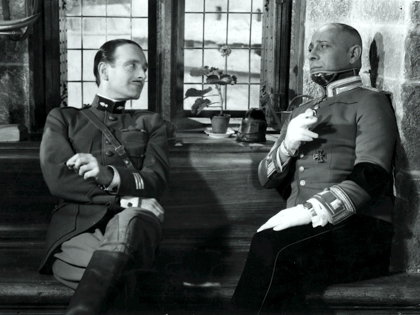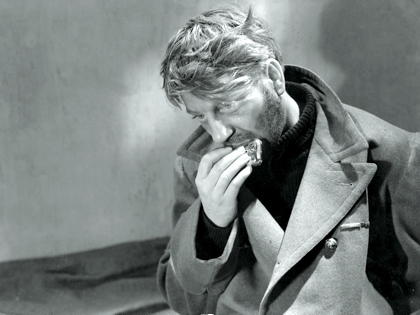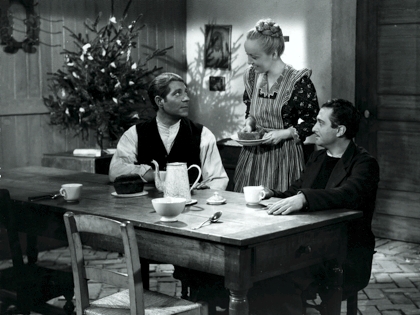Primary navigation


In past S&S polls of the greatest films of all time, Jean Renoir’s La Grande Illusion has lost out to his later, allegedly more personal film La Règle du jeu. It’s time to reconsider, says Ginette Vincendeau
Like all enduring classics, Jean Renoir’s La Grande Illusion (1937) comes to us encumbered with a lot of baggage. A resounding success in its time, made by the most canonical French filmmaker of the interwar era, it has been laden with prizes, consistently screened and much written about. This is a film with a legend. Yet at the same time it has not been untouched by controversy, while its status in the film canon is less secure than it might seem. The release of a new digital print by StudioCanal is a good opportunity to look at the reception of this mythic work both in its 1930s context and via its fluctuating reputation since, as a test not just of how a great work can mean so many different things to different people at different times, but also of the variability of critical agendas.
La Grande Illusion follows French prisoners of war in two German camps during World War I. The core group of officers includes the working-class Maréchal (Jean Gabin), the aristocrat de Boeldieu (Pierre Fresnay), the wealthy Jewish bourgeois Rosenthal (Marcel Dalio) and the comic music-hall actor Cartier (Julien Carette). Their attempt to tunnel out of the first camp (Hallbach) is foiled at the last moment by a transfer to the forbidding fortress of Wintersborn (in real life the Haut-Koenigsbourg chateau in Alsace) where they meet again the German officer glimpsed in the film’s prologue, Captain von Rauffenstein (Eric von Stroheim). From there, thanks to the sacrifice of de Boeldieu, Maréchal and Rosenthal finally escape. After being rescued by German widow Elsa (Dita Parlo), they eventually make it across the border to Switzerland.
An explicitly anti-war film, La Grande Illusion advocates human solidarity across national and class barriers: the French and German aristocrats bond over memories of Maxim’s and horses while the lower ranks on both sides are unanimous in their opinion that the war has gone on too long. Meanwhile the well-supplied Rosenthal shares food parcels with his comrades while de Boeldieu, knowing that his class is doomed, sacrifices himself to further the escape of his commoner fellow officers (“a nice present from the French revolution”, von Rauffenstein remarks).
Shot in the winter of 1936-37 and released on 8 June 1937, La Grande Illusion was a combination of autobiography, humanist statement and political tract. It bore the marks of the Popular Front’s left-leaning politics, in which Renoir had been closely involved; but with the Popular Front on the wane, those politics were already less clear-cut than in the director’s three 1936 films Le Crime de Monsieur Lange, Les Bas-fonds and the Communist-sponsored documentary La vie est à nous!.
A transitional film in this respect, before the noir pessimism of Renoir’s 1938 Zola adaptation La Bête humaine, La Grande Illusion is about class solidarity rather than class struggle. Its pacifism makes sense against a backdrop of international tension marked by the mounting threat of fascism and world war. Equally importantly, it was part of the strong current of anti-war feeling in France in the wake of World War I. In French that war was known as ‘la der des ders’ (‘the last of the last’) – and perhaps the most poignant of the multiple meanings of the title ‘grand illusion’ was the recognition that, sadly, it wouldn’t be the last.

In the details of its narrative, La Grande Illusion was also autobiographical, based on Renoir’s own memories of the war, in which he served as a pilot until he was shot down in April 1915 (Gabin wears Renoir’s old uniform in the film). To his own recollections he added those of his friend Pinsard, another pilot. Trouble flared when Renoir and scriptwriter Charles Spaak failed to acknowledge that their screenplay also drew on Jean des Vallières’s novel Kavalier Scharnhorst, leading to a plagiarism case. While there are similarities between the book and the film, they remain relatively minor. More significant were Spaak’s input and changes in the cast, especially the inclusion of von Stroheim and the consequent expansion of von Rauffenstein’s part (Renoir greatly admired the Austrian as a director).
As Martin O’Shaughnessy details in his excellent 2009 book on the film, while there was a consensus about the brilliance of La Grande Illusion from the point of view of style and performances, critics tended to address its subject-matter: “Its success was never narrowly cinematic because of its direct and obvious connection with the pressing issues of its day.” With the exception of a few right-wing writers – including fascist novelist Louis-Ferdinand Céline, who in his book Bagatelles pour un massacre odiously berated the sympathetic portrayal of the Jewish Rosenthal – most critics liked the film.
This consensus reflects both the film’s artistic success and its ability to express contradictory points of view – for instance, while national barriers are criticised as artificial, the film also indulges in national stereotypes. With the exception of Germany, where it was banned as Goebbels’s “cinematic enemy number 1”, La Grande Illusion was a triumph on the international scene too. It managed to please both Fascist Italy and Franklin D. Roosevelt, winning a raft of prizes including the ‘International Jury Cup’ at Venice and the New York Film Critics’ Circle award.
Much more controversial was the film’s French reception on its reissue in 1946. The audience still loved it, but this time round the critics were far less enthusiastic. Some cuts were made to the scenes concerning Rosenthal, as well as to the romantic episode between Maréchal and Elsa. Renoir’s adoption of US nationality in the same year may have accounted for some of the flak; but that aside, in the aftermath of World War II and the revelations of the Holocaust, three areas in particular appeared problematic: the film’s pacifism; its view of war as steeped in chivalry, with sympathetic portrayals of ‘good Germans’; and the representation of Rosenthal, which was now read as having anti-Semitic resonances.
The latter issue gave rise to a long series of debates that still continue today, centred on whether or not the film’s recourse to anti-Semitic stereotypes (Rosenthal as rich banker) and directly anti-Semitic remarks (Maréchal to Rosenthal: “I could never abide Jews”) were meant as a critique of anti-Semitism. The other questions, however, quickly receded into the background. On the one hand, the heated political divisions that informed film criticism in France gave way to other agendas; on the other, the reconstruction of Europe soon made the film’s pacifism and advocacy of rapprochement between nations seem relevant once again.
As it became detached from these polarised debates, La Grande Illusion was poised to start a different career as a classic. The 1950s saw the beginning of retrospective assessments of the history of cinema, marked by the appearance of a number of polls, in particular in Belgium in 1952 and 1958. Significantly, the 1952 list by the Brussels Cinémathèque and the 1958 list compiled on the occasion of the Brussels World Fair both included La Grande Illusion among the top ten (or 12) best films ever made. It’s worth looking at this a little closer.

The only French film by a French director included in 1958 (at no.5), La Grande Illusion figured in a list topped by Eisenstein’s Battleship Potemkin and also including Chaplin’s The Gold Rush, De Sica’s Bicycle Thieves, Dreyer’s The Passion of Joan of Arc, von Stroheim’s Greed, Griffith’s Intolerance, Pudovkin’s Mother, Welles’s Citizen Kane and Dovzhenko’s Earth. It’s a list strong in great films with ‘great themes’, in keeping with the period’s humanist ethos – something that would be disparaged by New Wave critics such as Claude Chabrol.
Indeed, as a response Cahiers du cinéma offered its own list (compiled by Bazin, Chabrol, Godard, Rohmer, Rivette and Truffaut, among others) in December 1958. This was their choice: Murnau’s Sunrise; Renoir’s La Règle du jeu; Rossellini’s Journey to Italy; Eisenstein’s Ivan the Terrible; Griffith’s Birth of a Nation; Welles’s Confidential Report (aka Mr Arkadin); Dreyer’s Ordet; Mizoguchi’s Ugetsu Monogatari; Vigo’s L’Atalante; von Stroheim’s The Wedding March; Hitchcock’s Under Capricorn and Chaplin’s Monsieur Verdoux.
There are many things to say about the differences between the two lists, such as the choice by Cahiers of both more modernist films (Journey to Italy) and more intimate drama (L’Atalante). Suffice it here to point out (beyond Cahiers’ typical provocation, replacing Citizen Kane with Confidential Report) the crucial shift from La Grande Illusion to La Règle du jeu – a momentous switch that would be echoed in many subsequent surveys, and notably in the ten-yearly Sight & Sound polls.
There, only La Règle du jeu appears in the top ten (at no.10 in 1952, no.3 in 1962, no.2 in 1972, 1982 and 1992, and no.3 in 2002). Knocked out of the A list, La Grande Illusion ends up among the also-rans – for instance appearing at no.38 in the 2002 Sight & Sound’s critics’ list. Similarly, Cahiers du cinéma’s 2008 list of ‘100 Greatest Films’ includes La Règle du jeu at no.3 and La Grande Illusion at no.68. Many other examples could be quoted that all illustrate the same basic shift in critical tastes.
As Robin Wood remarked, “In the days when film’s importance was attributed to the importance of its subject, [La Grande Illusion] was widely regarded as Renoir’s masterpiece,” but with the advent of auteurism in the 1950s, “it came to be perceived as a less personal, less intimate and less complex work.” I agree with Wood that this is a misconception, but it’s worth looking more closely at the reasons why the new critical consensus arose and endured.
The ‘easy’ accessibility of La Grande Illusion, its balanced structure in three acts (Hallsbach, Wintersborn, Elsa), the complex yet apparently seamless cinematography and the presence of major stars all signal a harmonious, classic film, whose subject is cohesion between individuals and nations. By contrast, the more ‘de-centred’ aesthetics of La Règle du jeu echo its theme of social disintegration. Thus for Truffaut, the fact that La Grande Illusion “is perhaps the least eccentric of all of Renoir’s French movies” is a reason to dampen his praise. When we add the presence of serious subject–matter – of a ‘great theme’, in Chabrol’s terms – we can almost see traces of New Wave accusations against the ‘tradition of quality’. Hence Truffaut also downplays La Grande Illusion for “serving a patriotic theme”.

La Grande Illusion’s popular success (it was the top-ranking film of 1937 at the French box office) is also a factor. In the Renoir canon, a legend has grown around La Règle du jeu’s supposed hostile reception in 1939. This has been shown by Renoir scholars Claude Gauteur and Christopher Faulkner to be a vast exaggeration, but the legend has endured that the film was ‘misunderstood’ at the time of its release, adding to its mystique and prestige. As Peter Wollen has pointed out, today’s highly ranked films like Citizen Kane and La Règle du jeu have the added aura of films maudits. This is not the case for La Grande Illusion, which along with Les Bas-fonds and La Bête humaine did very well commercially. Not coincidentally, all three starred Gabin, the leading French star of the time.
The use of actors is another key factor in the subsequent reputation of the film within the Renoir canon, for two reasons. First, another Renoir legend (initiated by Bazin) is that one of the director’s hallmarks was to use actors ‘against the grain’ – so for instance in La Règle du jeu there are relative unknowns (Nora Gregor), non-professionals (Renoir himself) or actors deliberately out of their expected register (Roland Toutain, a comic, as the tragic aviator Jurieux). In La Grande Illusion, on the contrary, the stars all work brilliantly within their registers – and consequently met with public approval. Gabin, Fresnay, Dalio and Carette, among others, give fabulous performances that were valued not just by the audience but by Renoir himself. As he said, “Each time I see the picture, I’m impressed by one idea. It is that you don’t do anything with bad actors… I know that I owe so much to the actors.”
The second point is the question of stars and authorship. Renoir’s happy sharing of the credit with his actors did not fit well with the auteur theory that advocated the director’s single vision. At the level of production, Gabin was instrumental in getting the film off the ground. At the level of reception, while Renoir was recognised and rewarded as the director of La Grande Illusion, the film was also seen as a great ensemble piece and, for a significant part of the audience, a ‘Gabin film’. By contrast, in those terms, La Règle du jeu cannot be anything but a ‘Renoir film’.
It’s clear that the critical debates that have shaped the reception of La Grande Illusion are, as ever, historically grounded. The film has ridden waves of critical approval and disapproval, yet through them continued to meet popular success. As a viewer’s comment on IMDb put it when La Grande Illusion dropped out of the website’s top 250 films in 2010 (typically, comparing it to La Règle du jeu), “This is a film that you can both appreciate AND enjoy!” While the immediate topic of the film is a specific war, the virulent debates in 1946 show its significance to a later war – and, consequently, its ability to speak to us today; issues of war, class and national conflicts have, sadly, not lost their relevance.
In its ensemble perfection, La Grande Illusion is also a snapshot of French cinema of the late 1930s at its absolute best. It is a classic in the terms defined by Frank Kermode: that is, a film not frozen in time, but open to different readings across times and cultures. In all these senses, then, Bazin’s verdict is as true today as it was when he wrote it in the late 1950s: “It is not enough to say that it has retained its power… the stature of the film remained undiminished by the passage of time.”
‘La Grande Illusion’ is rereleased in a new print on 6 April 2012, and plays until 19 April as part of a Jean Gabin season at BFI Southbank, London, before coming out on Blu-ray on 23 April
The star reborn: Ginette Vincendeau on how the French New Wave transformed the nature of film stardom (May 2009)
The River reviewed by Bryony Dixon (November 2004)
Divining the real: Peter Matthews on André Bazin (August 1999)
French Cancan reviewed by Catherine de la Roche (Autumn 1955)
Boudu Saved from Drowning reviewed by Tom Milne (Monthly Film Bulletin, November 1965)